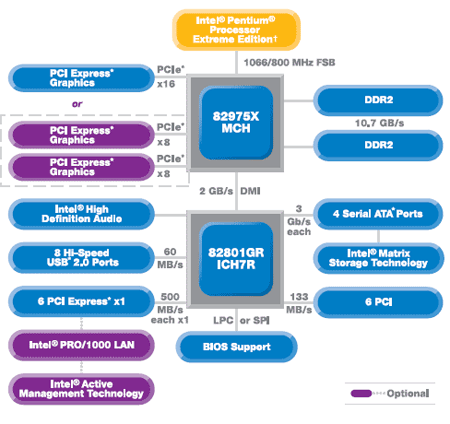
|
The four PCI Express slots are configured in x16, x0, x4, x0 mode when one videocard is installed. When two graphics cards are installed, say for ATI Crossfire, the four PCI Express slots are split up in x8, x8, x4, x8 mode.
86% Rating: 
|
|
|
|
Home >
Reviews >
Motherboards >
ASUS P5W64 WS Pro |
|
|
Intel's 975X Express Chipset
 The Intel 975X Express is Intel's flagship desktop and
workstation chipset. Early revisions of i975X motherboards were only compatible
with Intel Pentium 4/D processors, however the new generation of
975X Express-based boards support Intel Core 2 Duo. The Intel 975X Express is Intel's flagship desktop and
workstation chipset. Early revisions of i975X motherboards were only compatible
with Intel Pentium 4/D processors, however the new generation of
975X Express-based boards support Intel Core 2 Duo.
Intel has tweaked the 975X
Express somewhat to incorporate support of DDR2-800 memory, which is a nice
treat for a core logic that runs on the 1066/800MHz FSB. The Intel 975X Express
chipset is paired up with the ICH7-series Southbridge, an older model, but one
which supports four Serial ATA II channels along with a single IDE port for two
devices. The Southbridge found on the Asus P5W64 WS Professional motherboard is
the ICH7R version, and the R designates its inclusion of RAID
modes 0, 1, 0+1 and 5 for SATA hard drives.
DDR2-800 MHz memory support positions Intel's latest and
greatest CPU at par with AMD's Socket AM2 Athlon64 processors. Intel calls the
new memory controller FMA or 'Fast Memory Access', and it allows the system a
maximum theoretical bandwidth of 12.8GB/s. Below is breakdown on the full
feature set of the Intel 975 / 965 Express series chipsets, including the 975X
Express which the Asus P5W64 WS Professional motherboard is based upon.
| Intel 975 / 965 / 955 Series Chipset Feature
Breakdown |
|
Intel
975X Express |
Intel P965 Express |
Intel Q965 Express |
Intel G965 Express |
Intel Q963 Express |
Intel 955X Express |
| CPU |
LGA775 Core 2 Duo |
LGA775 Core 2 Duo |
LGA775 Core 2 Duo |
LGA775 Core 2 Duo |
LGA775 Core 2 Duo |
LGA775 Pentium D |
| Front Side Bus (FSB) |
1066/800 MHz |
1066/800/533 MHz |
1066/800/533 MHz
2 threads |
1066/800/533 MHz |
1066/800/533 MHz |
1066/800MHz |
| Intel Flex Memory Technology |
Yes |
Yes |
Yes |
Yes |
Yes |
Yes |
| Dual Channel Memory Support |
DDR2 800/667/533 |
DDR2 800/667/533 |
DDR2 667/533 |
DDR2 667 |
DDR2 667 |
DDR2 667/533 |
| Maximum Memory Capacity |
8GB |
8GB |
8GB |
8GB |
8GB |
8GB |
| Integrated Graphics |
- |
- |
GMA 3000 |
GMA 3000 |
GMA 3000 |
- |
|
PCI Express x16 |
2 |
1 |
1 |
1 |
1 |
1 |
|
PCI Express x1 |
4 |
4 |
4 |
4 |
4 |
4 |
| Intel Matrix Storage Technology |
Yes |
Yes |
Yes |
Yes |
Yes |
Yes |
|
SATA/IDE HDD |
4/1 |
6/0 |
6/0 |
6/0 |
6/0 |
4/1 |
|
SATA Speed |
3Gb/s |
3Gb/s |
3Gb/s |
3Gb/s |
3Gb/s |
3Gb/s |
|
RAID |
0, 1, 5, 10 (with ICH7R) |
0, 1, 5, 10 (with ICH7R/ICH8R) |
0, 1, 5, 10 (with ICH8R) |
0, 1, 5, 10 (with ICH8R) |
0, 1, 5, 10 (with ICH8R) |
0, 1, 5, 10 (with ICH7R) |
|
Hard Drive NCQ |
- |
Yes |
Yes |
Yes |
Yes |
- |
| USB 2.0 Ports |
8 |
8 |
10 |
10 |
10 |
8 |
| PCI Masters |
6 |
6 |
6 |
6 |
6 |
6 |
| Audio |
High Definition Audio (Azalia) |
High Definition Audio (Azalia) |
High Definition Audio (Azalia) |
High Definition Audio (Azalia) |
High Definition Audio (Azalia) |
High Definition Audio (Azalia) |
 |
 |
 |
 |
 |
 |
 | |
The Intel 975X
chipset supports two physical PCI Express x16 videocards, although when dual
videocard are configured the PCI Express x16 data bus is split evenly between
them. The 975X Express chipset is compatible with ATi CrossFire Edition
videocards, so you can have dual ATi Radeon videocards rendering at the same
time if you feel the need for enhanced gaming. If you're only using a single PCI
Express x16 videocard, insert it into the blue slot on the Asus P5W64 WS
Professional PCB.

A dedicated 2GB/s I/O bus
connects the Intel 975X Express Northbridge and Intel ICH7R Southbridge together.
The ICH7R
Southbridge incorporates four Serial ATA II channels with RAID 0, 1, 5, 10, a
7.1 channel Intel Azalia high definition audio codec, eight USB 2.0 slots, six
PCI Express x1 lanes and an integrated Intel Gigabit MAC which runs through the
PCI Express bus.
It's important
to note that the ICH7-series
of Southbridges support a single Parallel IDE channel. The latest Intel ICH8
chipset does away with parallel IDE support completely. A block chart of the
Intel 975X Express chipset's major features is illustrated above. Overclocking and benchmarks are
up next.
|
